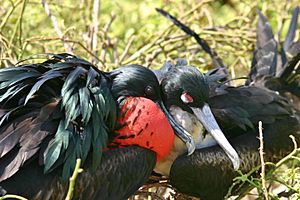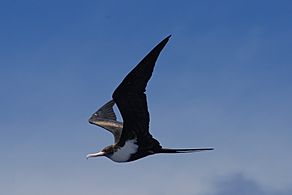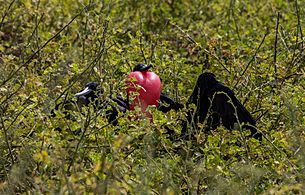Great frigatebird facts for kids
Quick facts for kids Great frigatebird |
|
|---|---|
 |
|
| Adult male, displaying, with inflated gular sac | |
| Conservation status | |
| Scientific classification | |
| Genus: |
Fregata
|
| Species: |
minor
|
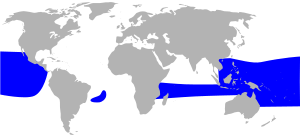 |
|
| Range map | |
| Synonyms | |
|
Pelecanus minor Gmelin 1789 |
|
The Great Frigatebird (Fregata minor) is a large seabird that belongs to the frigatebird family. You can find many of them nesting in the warm parts of the Pacific Ocean (like the Galápagos Islands) and the Indian Ocean. A small group also lives in the Atlantic Ocean.
Great Frigatebirds are big, light birds, growing up to 105 cm (about 3.5 feet) long. Most of their feathers are black. Males and females look different. Females are larger and have a white throat and chest. Males have a cool purple-green shine on their back feathers. During mating season, the male can puff up a bright red pouch on his throat. These birds eat fish they catch from the ocean surface while flying, especially flying fish. They also sometimes steal food from other birds, but not as often as other frigatebirds. They usually hunt within 80 km (50 mi) of their nesting or resting spots.
Contents
About the Great Frigatebird's Name
When a German scientist named Johann Friedrich Gmelin first described the Great Frigatebird in 1789, he thought it was a small pelican. So, he named it Pelecanus minor. The word minor means "smaller" in Latin. Even though it's a large bird and was later placed in a different bird group, its species name minor stayed the same. This is why it's called the "Great" Frigatebird, but its scientific name includes "minor."
The Great Frigatebird is one of five types of frigatebirds in their own special group, called a genus (Fregata). Their closest relative is the Christmas frigatebird.
Different Types of Great Frigatebirds
There are five main types, or subspecies, of the Great Frigatebird:
- F. m. aldabrensis: Found in the western Indian Ocean (like Aldabra and Comoros).
- F. m. minor: Lives in the central and eastern Indian Ocean and up to the South China Sea.
- F. m. palmerstoni: Found in the western and central Pacific Ocean (including Hawaii and the Galápagos Islands).
- F. m. ridgwayi: Lives in the eastern Pacific Ocean (like Cocos Island and the Galápagos Islands).
- F. m. nicolli: Found in the Atlantic Ocean (only on Trindade and Martim Vaz islands).
What Great Frigatebirds Look Like
Great Frigatebirds are about 85 to 105 cm (33 to 41 inches) long. Their wings can spread out very wide, from 205 to 230 cm (81 to 91 inches). Male frigatebirds are usually smaller than females. Males weigh about 1 to 1.45 kg (2.2 to 3.2 pounds), while females are heavier, weighing 1.2 to 1.6 kg (2.7 to 3.5 pounds).
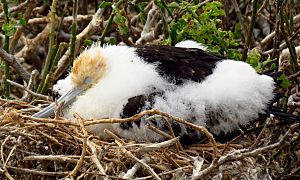
These birds have long, thin, pointed wings and a long, deeply forked tail. They have very large wings compared to their body weight. This helps them glide easily on warm air currents over the ocean.
Male frigatebirds have black feathers that can look green and shiny in the sunlight. Females are black with a white throat and chest, and they have a red ring around their eyes. Young frigatebirds are black with a rusty-white face, head, and throat.
Where Great Frigatebirds Live
Great Frigatebirds live all over the tropical oceans of the world. In the Pacific Ocean, you can find them as far north as Hawaii, where about 10,000 pairs nest. They also nest on many islands in the Central and South Pacific, from Wake Island to the Galápagos Islands. In the Indian Ocean, they live on islands like Aldabra and Christmas Island. The group in the Atlantic Ocean is very small and only lives on the islands of Trindade and Martin Vaz.
These birds travel a lot. Some birds tagged in Hawaii have been seen as far away as the Philippines. One male bird flew 4400 km (2734 mi) from Africa to the Maldives to find good fishing spots. Even though they travel far, they often return to the same place where they were born to breed.
Great Frigatebird Behavior
How Great Frigatebirds Find Food

Great Frigatebirds hunt in the open ocean, usually within 80 km (50 mi) of their nesting or resting areas. Their favorite food is flying fish. They also eat other fish and squid. They catch their prey while flying, either by grabbing it from just below the water's surface or by catching flying fish in the air. They often follow groups of tuna or dolphins, which push schooling fish closer to the surface. Frigatebirds cannot land on the water, and if they do, they usually can't take off again.
Sometimes, Great Frigatebirds will hunt the chicks of other seabirds, like sooty terns. Studies show that mostly female frigatebirds hunt chicks, and only a few individuals do most of this hunting.
Great Frigatebirds are also known for "kleptoparasitism"—they chase other seabirds, especially boobies and tropicbirds, until they throw up their food. The frigatebird then catches the thrown-up food in mid-air. However, this behavior doesn't provide most of their food. It's more like a snack or a supplement to what they catch themselves. One study found that frigatebirds got only about 5% of their food this way.
Great Frigatebird Reproduction and Life Cycle
Great Frigatebirds usually have one partner for a breeding season, which can last up to two years. They nest in large groups, called colonies, with thousands of other frigatebirds. They build nests in bushes and trees, or on the ground if there are no plants. They often share nesting areas with other birds, like red-footed boobies.
Male frigatebirds have a special red pouch on their throat called a gular sac. To attract a mate, males sit in bushes and puff up this sac like a bright red balloon. This takes about 20 minutes. As females fly by, the males shake their heads and wings and call out. Females watch many groups of males before choosing a partner. Once a pair forms, they will defend their nesting spot from other frigatebirds.
Building a nest can take a few days or up to several weeks. Males gather twigs and other materials from around the colony or even from the ocean surface. The female then builds the nest. Sometimes, they even steal nesting materials or whole nests from other birds! Their nests are big, loose platforms of twigs that get covered in bird droppings. They don't maintain the nests much, so they can fall apart before the season ends.
A female lays only one dull white egg each breeding season. It measures about 68 by 48 mm (2.7 by 1.9 inches). If the egg is lost, the pair usually breaks up. The female might find a new mate and lay another egg that same year. Both parents take turns sitting on the egg for 3 to 6 days at a time. This can be very tiring, and birds can lose a lot of weight during their shift.
The egg hatches after about 55 days. The chicks are born naked and helpless. They are covered in soft white down after two weeks. A parent guards the chick for another two weeks. Chicks are fed many times a day when they are very young, and then every one to two days as they get older. The chick puts its head inside the adult's mouth to get food that the parent brings up.
Parental care lasts a very long time for Great Frigatebirds. Chicks learn to fly after four to six months. Even after they can fly, they stay with their parents for another 150 to 428 days. This is one of the longest periods of parental care for any bird! The length of time depends on how much food is available in the ocean. Young birds also play games, like picking up a stick and being chased by other young birds. This play helps them practice the flying skills they need to catch fish.
Great Frigatebirds take many years to grow up and start breeding. Females are usually 8 to 9 years old, and males are 10 to 11 years old, before they can have their own chicks. They are thought to live a long time. In a study, some Great Frigatebirds were found to be 37 years old or older, and one was at least 44 years old!
Status of Great Frigatebirds
The Great Frigatebird has a very large population and lives in many places. Because of this, the International Union for the Conservation of Nature says it is a species of "Least Concern" for extinction. This means they are not currently in danger.
However, the small group of Great Frigatebirds in the South Atlantic (the F. m. nicolli subspecies) is in trouble. They used to live on Saint Helena and Trindade islands. The Saint Helena group disappeared a long time ago. On Trindade, their numbers have dropped a lot. The main island of Trindade used to have forests, but they were destroyed. Goats that were brought to the island ate all the new plants, stopping the forest from growing back. Also, wild cats hunted ground-nesting birds. Luckily, programs in the late 1900s removed most of the animals that were harming the birds. In Brazil, where this subspecies still lives, the Great Frigatebird is considered "critically endangered".
Gallery
See also
 In Spanish: Rabihorcado grande para niños
In Spanish: Rabihorcado grande para niños





